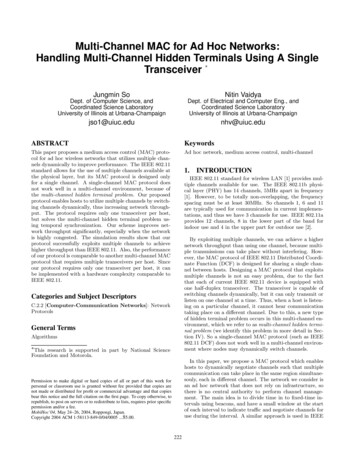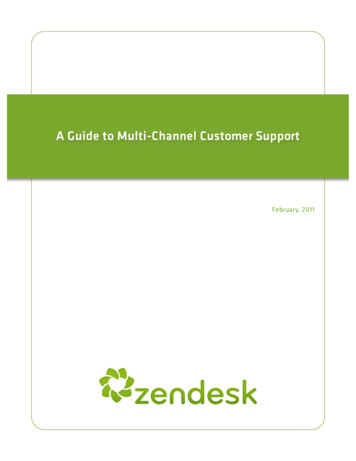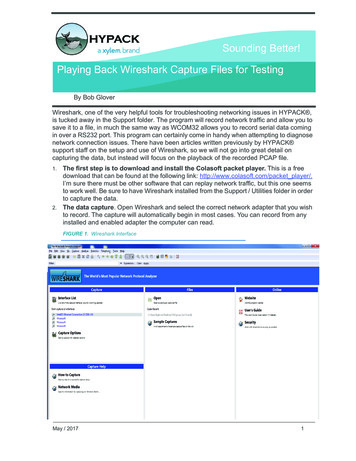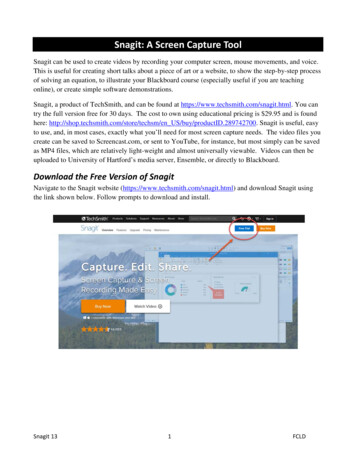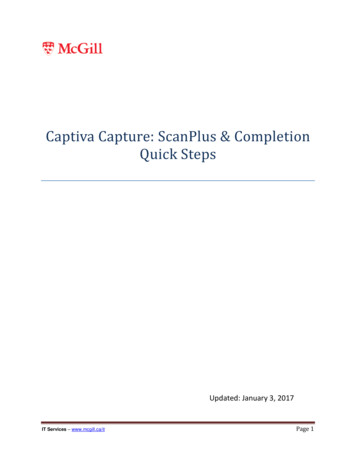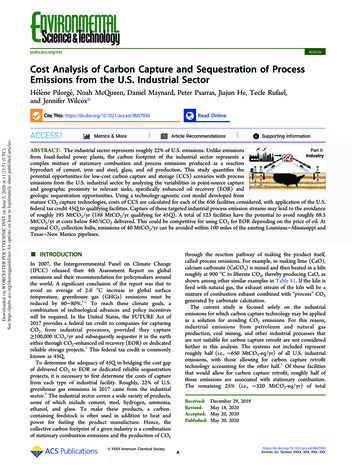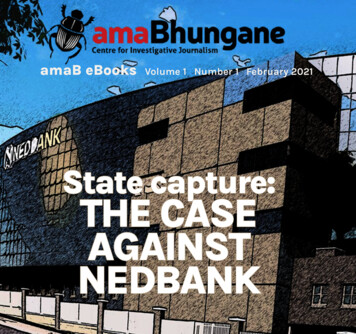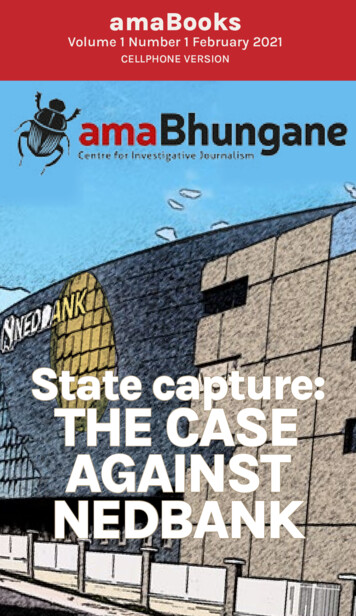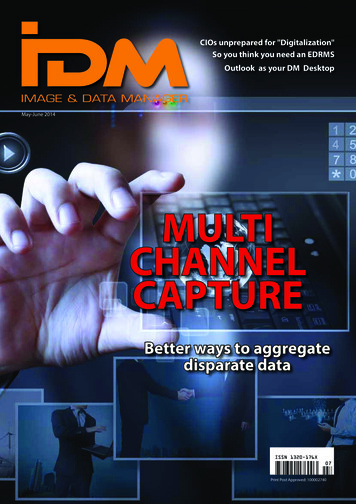
Transcription
CIOs unprepared for "Digitalization"So you think you need an EDRMSOutlook as your DM DesktopMay-June 2014MULTICHANNELCAPTUREBetter ways to aggregatedisparate dataPrint Post Approved: 100002740
IN THIS ISSUE6 SO YOU THINK YOU NEED AN EDRMS10 THE SHAREPOINT OUTLOOKMacroView’s Noel Williams explores the functionality and UIfeatures business users need from SharePoint.Are EDRMS implementations achieving the outcomes that organisations were expecting?8 SHAREPOINT & TRIMBetter together or apart?An expanding array of options deliver ways to better aggregatedisparate data and make it intelligently useful for the enterpriseand automate business processes.19 DATA GOVERNANCE TOOLSPublisher/EditorBill DawesAudited Circulation:average netdistribution 5,633for period endedMarch 31, 201414 BEYOND THE DOCUMENTAs more organisations looking toward data governance as astrategic enterprise competence, do the tools measure up?22 YOUR RETIREMENT OPTIONSPublished by:Transmit Media Pty LtdABN 631 354 31659PO Box 392, Paddington NSW2021, AustraliaTelephone: 61 (2) 9043 2943Fax: 61 (2) 8212 8985email: idm@idm.net.auAll material in Image & Data Manager is protected under the CommonwealthCopyright Act 1968. No material may be reproduced in part or whole in anymanner whatsoever without the prior written consent of the Publisher and/or copyright holder. Editorial contributions are welcome. All resonable effortshave been made to trace copyright holders.The Publisher/Editor bears no responsibility for lost or damaged material. Theviews expressed in Image & Data Manager are not those of the Editor. Whileevery care has been taken in the compilation of editorial, no responsibilitywill be accepted by the Editor for omissions or mistakes within. The Publisherbears no responsibility for claims made, or for information provided by theadvertiser.How Tasmania’s Retirement Benefits Fund retired a set of legacyapplications and host all the data instead in its TRIM EDRMS.26 CUSTOMER ORDER PROCESSINGImprove business processes within the order-to-cash cycle andgain a competitive edge.30 TOOLS & TECHNOLOGYImage & Data Manager 1
NEWSGoogle Drive gets Office friendlyRecords SNAFU get out of jail free cardOne of the bugbears of the Google Apps ecosystem is being addressed with the launch of Google Drive for Work, which promisethe ability to open Microsoft Office documents natively withoutthe need to translate into Google Docs format. So now Google'soffice suite will also be able to edit and save Microsoft Officedocuments.Priced at US10/user/month, Google Drive for Work includes unlimited storage (allowing up to 5TB file uploads), advanced auditreporting and new security controls.The ability to work in a similar way to Microsoft Office TrackChanges also comes via a new feature called "Suggest Edit"mode. This enhances collaboration in Drive so that collaboratorscan suggest a change to a shared document, which can then beaccepted or rejected with a single click.The Office Compatibility Mode is currently available on Androidand Chrome browsers with iOS support promised.New fine-grained controls let admins manage which employeescan install the desktop sync client. Also, a new audit view provides analysis of who is moving, deleting or sharing a file withinor outside the company, and an audit API will also be availablefor developers. Apps Vault, Google’s solution for search anddiscovery for compliance needs, is also included with Drive forWork, expanding to cover all content stored in Drive, includingDocs, Sheets and Slides, as well as any other file type.Problems implementing a US4 million Law Enforcement Records Management solution in Dallas, Texas have allowed morethan 20 inmates — some suspected of felonies – to walk free. TheDallas News reported that Deputy Chief Christina Smith, who isoverseeing the implementation, said authorities are refiling casesand trying to find the suspects to get them back in jail.The system went live on June 1 2014 after being purchased fouryears ago. Smith promised that the issues will improve with time,familiarity and planning.“We kind of relate it to getting a new car,” Smith told the newspaper. “You needed a new car, but you’re not familiar with where allthe gadgets are on it.”Dallas Police Chief David Brown was reported to have told a CityCouncil Budget, Finance and Audit Committee hearing that theproblems are “nothing unexpected.” He said some officers initiallyreceived training months ago and may have forgotten how touse the new system.“We’ve got like three generations of cops working for us,” Brownsaid. “Some of the younger cops get it much quicker and better.Some of the veterans have more difficulty with technology, so ittakes a little bit more of a learning curve.”Proficiency Group wins Kofax Award(l to r) Reynolds C. Bish - CEO, Kofax; lex White – Technical Director, Sigma Data Solutions; Lisa Read White – Director, SigmaData Solutions; Howard Dratler - Executive Vice President, FieldOperations, KofaxThe Proficiency Group has been named Kofax’s Asia PacificPartner of the year at Transform 2014, Kofax's annual customerand partner conference, which drew a record 750 attendees from32 countries. The Proficiency Group provide ICT Services withinthe fields of Business Process Management and InformationGovernance. Trading under the name Sigma Data Solutions theorganisation provides solutions to improve business processefficiency, improved customer service, reduce processing costsand achieve regulatory compliance.The winners were chosen by an expert panel of judges comprised of Kofax executives and independent industry expertsSandy Kemsley of Kemsley Design, and David Tyler, Editor of theUK's document and content management publication entitledDocument Manager."These winners truly embody the theme of Transform 2014," saidGrant Johnson, Chief Marketing Officer at Kofax. "They‘ve takenKofax products and solutions and deployed them in innovativeways to increase responsiveness to customers, provide a higherlevel of service, gain competitive advantage and better manageand grow their businesses. We applaud every winner for puttingaction behind their vision."2 Image & Data ManagerPort Stephens cleans up with ControlPointiCognition, has won a contract to deploy HP’s key informationanalysis and legacy data clean-up software, HP ControlPoint, atNSW’s Port Stephens Council.“This is one of the first deployments of HP ControlPoint in thecountry, and it will provide Port Stephens Council with the abilityto identify, connect and control information across enterprisesystems,” said iCognition company Principal Nigel Carruthers-Taylor,“We will initially use ControlPoint to understand, classify, andreduce outdated and unnecessary content in file repositories andHP TRIM, but later we see it expanding into Microsoft Exchange,SharePoint and Council websites.”HP ControlPoint helps organisations achieve information compliance by making it possible to apply disposition of policies toinformation in-place, or the migration of targeted legacy datato HP TRIM for appropriate records management and improvedinformation access.“It’s a key enabling technology for legacy data clean-up”, said MrCarruthers-Taylor.“ControlPoint helps tackle information sprawl and shine a lighton dark data that is sitting unmanaged in email repositories,file shares, and SharePoint sites. We look forward to helping theCouncil identify, value and harness their enterprise information.”IBM Research sets Big Data recordIBM researchers have demonstrated a new record of 85.9 billionbits of data per square inch in areal data density on low-cost linear magnetic particulate tape - a significant update to one of thecomputer industry's most resilient, reliable and affordable datastorage technologies for Big Data.At this areal density, a standard LTO size cartridge could storeup to 154 trillion bytes (154 terabytes) of uncompressed data - a62 fold improvement over an LTO6 cartridge, the latest industry-standard magnetic tape product. To put this into perspective,154 terabytes of data is sufficient to store the text from 154million books.This new record was achieved using a new advanced prototypetape, developed by FUJIFILM Corporation of Japan.The areal density demonstration represents a potential increasein capacity of 77,000,000 times compared with IBM’s first tapedrive product released over 60 years ago. . It used reels of halfinch-wide tape that each had a capacity of about 2 megabytes.
NEWSNational Archives reports 95% ofagencies will be digital by 2015Australia’s Digital Transition is on track, with 95% of Commonwealth agencies reporting they will have digital records andinformation management in place by 2015, according to thelatest assessment from National Archives of Australia (NAA).NAA Director-General David Fricker told the Information: theCurrency of the Digital Economy conference held in Canberra onMay 29 “This is a great result!“It shows that across the Commonwealth we have the strategicleadership, the expertise, the technology and the commitmentto achieve this essential public sector reform.”The Digital Transition Policy, announced in 2011, aims to migratemore than 200 Commonwealth Government Agencies, from theABC to the Workplace Gender Equality Agency (WGEA), to digitalrecord-keeping.It aims to promote the scanning of incoming paper records andstates that records that are created digitally after 2015 will beaccepted for transfer to the National Archives in digital formatsonly.However in 2013, more than one third of CommonwealthAgencies reported they are still printing some digital records topaper, and only 65 per cent have adequate strategies in place tomanage digital information for as long as it is required.”“Of course, every silver lining has a grey cloud,” said Fricker, whonoted that: Forty per cent of agencies report duplication of records inboth digital and physical formats, with 20 per cent reportingrelatively high levels of duplication; only 65 per cent of agencies have adequate strategies to manage electronic records for as long as they are required (up from54 per cent in 2012 and 46 per cent in 2011); and Despite significant improvements, the extent to which agencies scan incoming paper records remains low at 65 per cent.A final assessment of Commonwealth agencies' digital information management maturity and capabilities will be undertakenfrom July 1 to September 30 2014, after which the NAA willreport to government to determine future strategies.Fricker announced that the NAA would be setting new targetsfor 2020 that include: all new business and ICT systems and tools will comply withthe International standard ISO 16175, Principles and FunctionalRequirements for Records in Electronic Office Environments; agencies will make and record business decisions digitally,using digital authorisations and workflows; the Archives will develop a Commonwealth data interoperability standard for safe, trusted and efficient sharing and re-useof digital information between agencies; all agencies will meet minimum metadata standards set bythe National Archives so digital content is described, shareableand re-usable; all agencies will meet standard professional records and information management specialist qualifications, skills and capabilities set by the National Archives.Objective reappointed for NSW Govt.Objective Corporation has been re-appointed as an accreditedsupplier to the NSW Government under the NSW ICT Softwareagreement (Contract 607).Tony Walls, CEO of Objective Corporation said, “Objective’sappointment to the NSW ICT Software agreement highlights ourproven ability to deliver solutions that meet the requirementsof NSW Government organisations and our alignment with theNSW Government’s ICT Strategy.”4 Image & Data ManagerNAA undertakes itsown Digital TransitionAs an example of the NAA “walking the walk, not just talking the talk”, the National Archives of Australia (NAA) hasundergone its own Digital Transition for the process of authorising records authorities – implementing an electronicworkflow via its TRIM EDRMS.Anne Lyons, NAA Assistant Director-General, told theHP Information Governance forum in Sydney, “Records Authorities, which the NAA issues, gives Australian governmentAgencies permission to legally dispose of Commonwealthrecords once they are no longer needed. They also provideinstructions for the disposal of records including identifying which records are of enduring value and transfer to theArchives. Under the Act no record can be destroyed unlessits authorised by the National Archives, and that’s what a Records Authority does, so Records Authorities are significantto agencies and are a very central legislative function of thearchives.”Until last year these Authorities were authorised by theNAA Director General with a wet signature, and this processhas now been digitised with records created and manageddigitally all the way through.“The key drivers for us in selecting this process were thatwe are the lead agency for the Digital Transition and thus required to meet the policy ourselves as any other agency,” saidLyons."It also was able to give us a benefit of building experienceand identifying pathways internally as well as supporting anddeveloping advice to other agencies, so practically implementing what we were advising others to do, walk the walk as wellas talking the talk.”After undertaking risk assessment and developing a business case a number of technical options for digitising Authorisation were investigated. Initially the process was digitisedthrough the exchange of Authorisation emails and capture ofrecords in the EDRMS used in TRIM.“We took advantage of the existing technologies and processes in TRIM and so we used the TRIM workflow tracking to notify staff of actions they need to perform and torecord completed actions within the system itself includingthe electronic authorisation. So the press of a button by theauthorised person using that system included the final Records Authority endorsement and authorisation by the Director-General,” said Lyons.“It was a tracking workflow that we used, started and completed electronically, emailed to agencies and published online end to end digital. It has been accepted by agencies and isworking extremely well, with no paper in the process.”Objective solutions have been engineered in Australia to meetthe requirements of government and regulated industries.Objective ECM 8 is widely used by public sector organisationsin NSW and around the world to effectively manage the largeamount of content and knowledge that proliferates all levelsof government, managing electronic information securely andensuring transparency and auditability.Tony Walls said, “Objective is pleased to be working with theNSW Government to simplify the procurement process for theirdepartments and agencies when they procure Objective products and services and are looking forward to helping.”
Transform the way you work with PDF files.ABBYY PDF Transformer is a new and comprehensive solution for working intelligently with PDFdocuments. It covers the entire cycle of a document’s life: from creation, discussion, approval, andprotection, to the conversion of PDF files into editable formats, merging of documents, and extraction oftext and images.The only PDF tool you’ll ever need; Edit &ModifyOpen and view PDF documents with an intuitive user interfaceAdd and remove individual pages, text or images in PDFsReview and commentTransform PDF files into all MS supported formatsTransform scanned or digital PDF files into editablesearchable formats including PDF/ASplit and merge PDF filesCreate and/or merge from file or scanned documentsEdit typos, errors and make small text editsProtect and share - redact sensitive informationFlexible licensing model to meet all of your technicaland financial requirements.SINGLEDESKTOPLICENSE 89 (exGSTOpen &ViewExtract &ReuseCreate &Merge)Significant discounts for multiplelicenses, annual subscriptions andsite licenses. Contact us!For more information visit - www.abbyy.com.au/pdftransformerABBYY is a leading provider of document recognition, data capture and linguistic software.sales@abbyy.com.au www.abbyy.com.auReview &CommentProtect &Share
DOCUMENT MANAGEMENTSo you think you need an EDRMSBy Kate FuellingWhile I am a keen advocate of electronic documentand records management systems (EDRMS), whenclients ask me if its the first thing they need, my answer is usually ‘no it's not’.Am I talking in oxymorons or am I just a moron? Shall we askour panel of judges?One Umbrella Consulting recently ran a nationwide survey tosee if EDRMS implementations were achieving the outcomesthat organisations were expecting. Respondents were balancedbetween industries and organisational size, and were primarilyrecords management people.Some of our survey findings may surprise you, some may not.You may shake your head at what some organisations don’t doand you may even recognise a little of your own organisation.Do any of these findings sound familiar? Only 20% surveyed stated that they had clear advice as towhere to save information (Fig. 1) Only 40% of respondents thought their organisation manages their information very well or well (Fig. 2) Less than 50% had organisation-wide RM training and 37%had no training available at all (Fig. 3)But what did ring true for all the organisations surveyed is thatmany of the main problems cited were nothing to do withsystems at all.Here are a few of the comments:"Lack of collaboration, lack of RM Knowledge, silo mentality ."Lack of face-to-face support, rift between document controllersand Information managers ."Duplication of processes. No clear guidelines & Policies. Highturnover of staff and less training opportunities ."No buy-in from the management - no importance placed oninformation management ."And if the practices in Fig. 1 are anything to go by, you’ll understand that these are going to manifest in retrieval problems. Itis, therefore, hardly surprising to learn that half of all respondents indicated that their organisations experience a high levelof frustration when searching for information frequently, ifnot on a daily basis, and that searches often came back withincomplete results.But what was the most telling finding of all?Over three quarters of respondents stated their organisationuse a system other than network drives (Fig. 4) to store documents and records.So even with some form of an EDRMS (and yes, we’re includingSharePoint in this mix), records management problems are stilloccurring. It looks as though our judges may agree with us.implementing an EDRMS will not miraculously solve your records management problems. We’re through to the next round.But the next round is tougher. Why not?Fig. 1 How do people know where to save informationFig. 2 How well does your organisation manage information?Fig. 3 Availability of Records Management trainingFig. 4 Do you have an EDRMS?6 Image & Data Manager
2012 ABBYY. All rights reserved. ABBYY, the ABBYY Logo, FlexiCapture are either registered trademarks or trademarks of ABBYY Software Ltd.ACA Pacific,Phone: 1300 761 199Email: sales@acapacific.com.auWeb: www.acapacific.com.auABBYY is a leading provider of document recognition,data capture and linguistic software.For more information, visit www.abbyy.com.auEmail: sales@abbyy.com.auProudly Distributed byABBYY FlexiCapture 10 is server-based solution, designedfor low- to high-volume automated data capture and dataextraction software.Take the Data. Leave the Paper.Generally when an organisation is considering such a large investment as anEDRMS, they have significant business drivers. And generally in our experience, these drivers seem to be "we’ve been audited or we’ve gone to court andbeen publicly roasted for our lack of records management" or "we’re a government organisation so we need one".Hardly ever do I hear something like "it’s the next
HP ControlPoint helps organisations achieve information com-pliance by making it possible to apply disposition of policies to information in-place, or the migration of targeted legacy data to HP TRIM for approp
